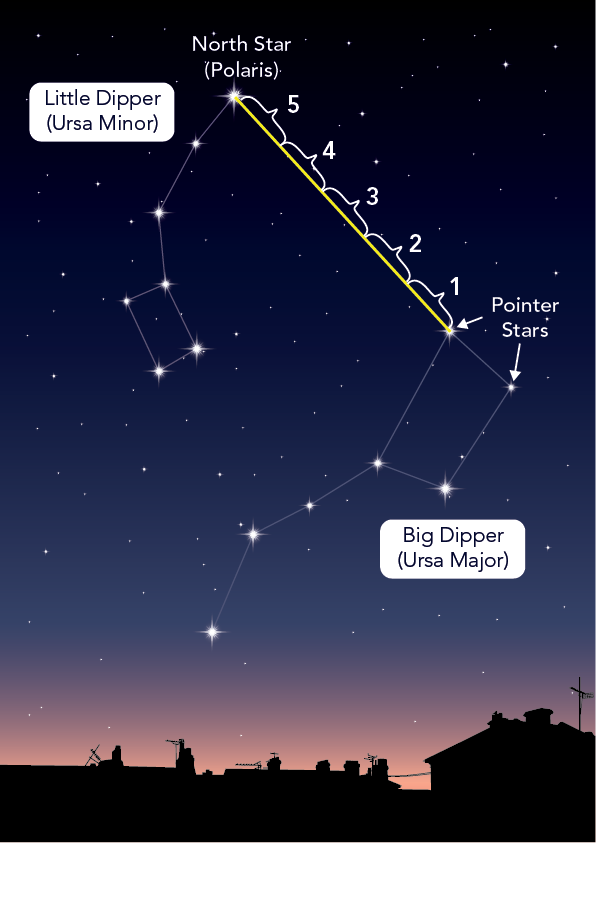How can I tell which way is north at night?

Compass pointing north (LdF, iStockphoto)

Compass pointing north (LdF, iStockphoto)
How does this align with my curriculum?
Do you like to look at the stars? What can you identify in the night sky? Try finding some important constellations tonight!
What You Need
- Image of the Big Dipper and the Little Dipper constellations
- 14 glow-in-the-dark stickers (stars or dots) (optional)
- Flashlight with red cellophane covering the light end (optional)
What To Do
- Print out a copy of the Big Dipper and Little Dipper images.
- Stick glow-in-the-dark stickers (stars or dots would be best) over the stars of the Big Dipper and Little Dipper. Use larger stickers for the North Star (Polaris) and the Pointer Stars (See diagram - these are stars that point to the North Star).
- Just before you go outside, hold the image with the glow-in-the-dark stickers under a strong light source for several minutes.
- If you don't have access to glow-in-the-dark stickers, you can cover the end of a flashlight with red cellophane and shine this on the image when you're outside (this way you can look at the image and the night sky without losing your 'night vision')
- Go outside to a dark area where you have a clear view of the night sky above you. Locate the Big Dipper (Ursa Major); it looks like a big pot in the sky.
- Once you have located the Big Dipper, find the two 'Pointer Stars' on the end of the 'pot' portion of the Big Dipper. Imagine a line that extends up past the Pointer Stars that is five times as long as the distance between the Pointer Stars. You will find a star at the end of that line, which is at the end of a constellation that looks like a similar version of the Big Dipper. This is the North Star!

Discovery
A constellation is a group of stars in the sky that form a fixed pattern in relation to each other, as viewed from the Earth. Astronomers currently recognize 88 constellations in the Northern and Southern hemispheres. Our modern constellation system comes to us from the ancient Greeks. No one is sure exactly where, when or by whom this system was invented. The constellations are believed to be totally imaginary things that poets, farmers and astronomers have made up over the past 6,000 years.
The Little Dipper (Ursa Minor, The Little Bear) is a special constellation because the last star on the handle is the North Star (Polaris).
The North Star is important not because of its brightness, but because it is the only star that never appears to change its place in the sky. Even while the other stars and constellations are moving, Polaris stays put! If you are in the northern hemisphere, you can always tell which way is north if you can find the North Star.
- The North Star is not visible in the southern hemisphere. Is there a star that is the equivalent of the North Star in the southern hemisphere?
For more information about this topic check out these Let's Talk Science resources:
- The Life and Death of Stars (STEM in Context) - The life and death of stars form the chemical elements that make up Earth, making stars critical to life as we know it.
- Rachel Ward-Maxwell (Career Profile) - Rachel works as a Researcher-Programmer in the field of Astronomy and Space Sciences.
What’s happening?
A constellation is a group of stars in the sky that form a fixed pattern in relation to each other, as viewed from the Earth. Astronomers currently recognize 88 constellations in the Northern and Southern hemispheres. Our modern constellation system comes to us from the ancient Greeks. No one is sure exactly where, when or by whom this system was invented. The constellations are believed to be totally imaginary things that poets, farmers and astronomers have made up over the past 6,000 years.
The Little Dipper (Ursa Minor, The Little Bear) is a special constellation because the last star on the handle is the North Star (Polaris).
Why does it matter?
The North Star is important not because of its brightness, but because it is the only star that never appears to change its place in the sky. Even while the other stars and constellations are moving, Polaris stays put! If you are in the northern hemisphere, you can always tell which way is north if you can find the North Star.
Investigate further
- The North Star is not visible in the southern hemisphere. Is there a star that is the equivalent of the North Star in the southern hemisphere?
For more information about this topic check out these Let's Talk Science resources:
- The Life and Death of Stars (STEM in Context) - The life and death of stars form the chemical elements that make up Earth, making stars critical to life as we know it.
- Rachel Ward-Maxwell (Career Profile) - Rachel works as a Researcher-Programmer in the field of Astronomy and Space Sciences.